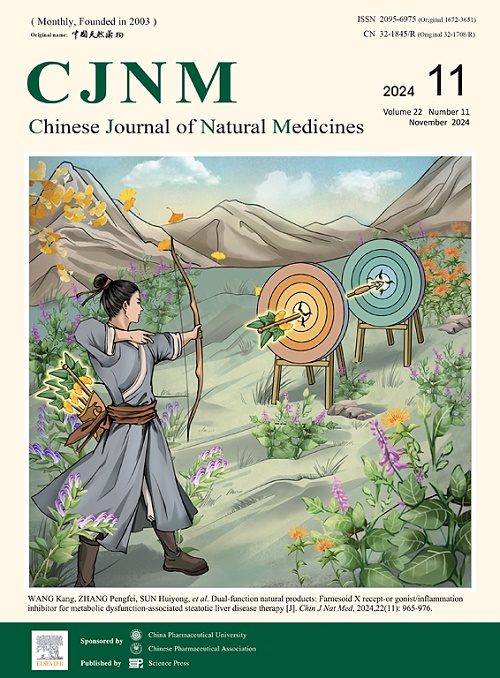The role of 8-OxoG and its repair systems in liver diseases progression: responsible mechanisms and promising natural products
IF 4.9
2区 医学
Q1 INTEGRATIVE & COMPLEMENTARY MEDICINE
引用次数: 0
Abstract
The accumulation of deoxyribonucleic acid (DNA) oxidative damage mediated by reactive oxygen species (ROS) is closely associated with liver diseases. 8-Oxoguanine (8-OxoG), a prevalent DNA oxidation product, plays a significant role in liver disease progression. The base excision repair (BER) pathway, comprising over 30 proteins including 8-OxoG DNA glycosylase1 (OGG1), MutY homolog (MUTYH), and MutT homolog protein 1 (MTH1), is responsible for the clearance and mismatch repair of 8-OxoG. Abnormally high levels of 8-OxoG and dysregulated expression and function of 8-OxoG repair enzymes contribute to the onset and development of liver diseases. Consequently, targeting the 8-OxoG production and repair system with agonists or inhibitors may offer a promising approach to liver disease treatment. This review summarizes the impact of 8-OxoG accumulation and dysregulated repair enzymes on various liver diseases, including viral liver disease, alcoholic liver disease (ALD), metabolic dysfunction-associated steatotic liver disease (MASLD), cholestatic liver disease (CLD), liver fibrosis, cirrhosis, and liver cancer. Additionally, we review natural constituents as potential therapeutic agents that regulate 8-OxoG production, repair enzymes, and repair system-related signal pathways in oxidative damage-induced liver diseases.
8-OxoG及其修复系统在肝脏疾病进展中的作用:负责任的机制和有前途的天然产物
活性氧(ROS)介导的脱氧核糖核酸(DNA)氧化损伤积累与肝脏疾病密切相关。8-氧鸟嘌呤(8-OxoG)是一种常见的DNA氧化产物,在肝脏疾病的进展中起着重要作用。碱基切除修复(BER)途径由30多种蛋白质组成,包括8-OxoG DNA糖基化酶1 (OGG1)、MutY同源蛋白(MUTYH)和MutT同源蛋白1 (MTH1),负责8-OxoG的清除和错配修复。异常高水平的8-OxoG和8-OxoG修复酶的表达和功能失调有助于肝脏疾病的发生和发展。因此,用激动剂或抑制剂靶向8-OxoG的产生和修复系统可能为肝脏疾病的治疗提供了一种有希望的方法。本文综述了8-OxoG积累和修复酶失调对各种肝脏疾病的影响,包括病毒性肝病、酒精性肝病(ALD)、代谢功能障碍相关的脂肪变性肝病(MASLD)、胆汁淤积性肝病(CLD)、肝纤维化、肝硬化和肝癌。此外,我们回顾了天然成分作为潜在的治疗药物,在氧化损伤引起的肝脏疾病中调节8-OxoG的产生、修复酶和修复系统相关信号通路。
本文章由计算机程序翻译,如有差异,请以英文原文为准。
求助全文
约1分钟内获得全文
求助全文
来源期刊

Chinese Journal of Natural Medicines
INTEGRATIVE & COMPLEMENTARY MEDICINE-PHARMACOLOGY & PHARMACY
CiteScore
7.50
自引率
4.30%
发文量
2235
期刊介绍:
The Chinese Journal of Natural Medicines (CJNM), founded and sponsored in May 2003 by China Pharmaceutical University and the Chinese Pharmaceutical Association, is devoted to communication among pharmaceutical and medical scientists interested in the advancement of Traditional Chinese Medicines (TCM). CJNM publishes articles relating to a broad spectrum of bioactive natural products, leading compounds and medicines derived from Traditional Chinese Medicines (TCM).
Topics covered by the journal are: Resources of Traditional Chinese Medicines; Interaction and complexity of prescription; Natural Products Chemistry (including structure modification, semi-and total synthesis, bio-transformation); Pharmacology of natural products and prescription (including pharmacokinetics and toxicology); Pharmaceutics and Analytical Methods of natural products.
 求助内容:
求助内容: 应助结果提醒方式:
应助结果提醒方式:


